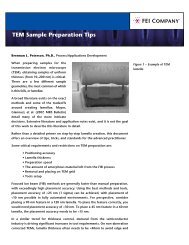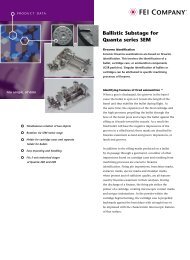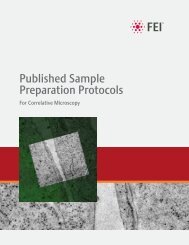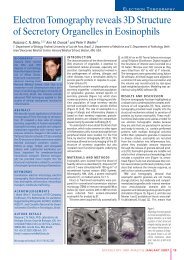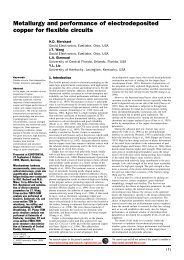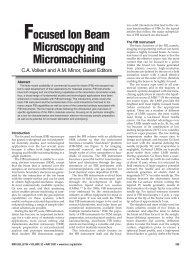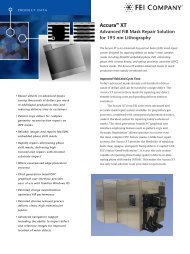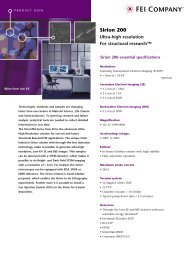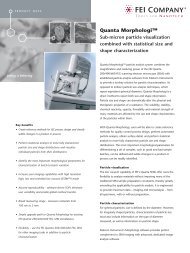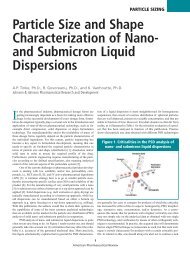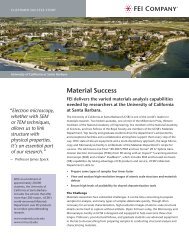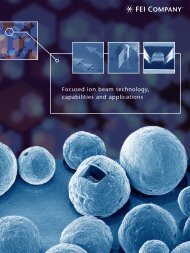Wet STEM: A newdevelopment in environmental SEM for imaging ...
Wet STEM: A newdevelopment in environmental SEM for imaging ...
Wet STEM: A newdevelopment in environmental SEM for imaging ...
Create successful ePaper yourself
Turn your PDF publications into a flip-book with our unique Google optimized e-Paper software.
Fig. 8. Natural rubber latex (NRL): (a) droplet imaged at<br />
30 kV <strong>in</strong> annular dark-field wet <strong>STEM</strong> conditions without<br />
sta<strong>in</strong><strong>in</strong>g or other preparation: pure NRL, (b) ultramicrotomy<br />
foils encapsulated <strong>in</strong> a res<strong>in</strong> and imaged at 30 kV <strong>in</strong> annular<br />
dark-field <strong>STEM</strong> conditions. Scale bar length: 1 mm.<br />
to the hairy-layer morphology of poly DMAEMA<br />
grafted particles.<br />
In addition, if the size distribution of particles is<br />
very large <strong>for</strong> both of the latices, their average size<br />
seems to change with graft<strong>in</strong>g. Non-grafted<br />
particles exhibit slightly smaller diameters than<br />
grafted ones. These observations confirm the<br />
results obta<strong>in</strong>ed by dynamic light scatter<strong>in</strong>g measurements<br />
per<strong>for</strong>med with a Beckman Coulter<br />
apparatus, Mod. LS230: a mean diameter of<br />
170 nm is obta<strong>in</strong>ed <strong>for</strong> non-grafted particles and of<br />
210 nm <strong>for</strong> particles grafted with poly DMAEMA.<br />
The comparison between wet <strong>STEM</strong> images and<br />
<strong>STEM</strong> images of foils prepared by ultramicrotomy<br />
is quite <strong>in</strong>terest<strong>in</strong>g. Both are precious <strong>for</strong> the<br />
characterization of morphologies result<strong>in</strong>g from<br />
ARTICLE IN PRESS<br />
A. Bogner et al. / Ultramicroscopy 104 (2005) 290–301 297<br />
Fig. 9. Natural rubber latex (NRL) grafted with poly(DMAE-<br />
MA): hairy-layer morphology: (a) droplet imaged at 30 kV <strong>in</strong><br />
annular dark-field wet <strong>STEM</strong> conditions without sta<strong>in</strong><strong>in</strong>g or<br />
other preparation, (b) ultramicrotomy foils encapsulated <strong>in</strong> a<br />
res<strong>in</strong>, and imaged at 30 kV <strong>in</strong> annular dark-field <strong>STEM</strong><br />
conditions. Scale bar length: 500 nm.<br />
graft<strong>in</strong>g. But there is an important difference<br />
between these samples <strong>in</strong> the time required <strong>for</strong><br />
preparation, s<strong>in</strong>ce wet <strong>STEM</strong> does not require<br />
any. Although no sta<strong>in</strong><strong>in</strong>g has been per<strong>for</strong>med on<br />
samples imaged <strong>in</strong> wet <strong>STEM</strong> mode, the result<strong>in</strong>g<br />
contrast is greater. It should be noted that wet<br />
<strong>STEM</strong> contrast of particles differs from <strong>STEM</strong><br />
images of ultramicrotomed foils. In the first case,<br />
we pass through a whole particle (edges th<strong>in</strong>ner,<br />
i.e. darker than centre), whereas <strong>in</strong> the second<br />
case, only a slice of particle is imaged (one grey<br />
level). At last, the comparative study constitutes a<br />
good validation of the wet <strong>STEM</strong> techniques.<br />
It can be noted that wet <strong>STEM</strong> imag<strong>in</strong>g br<strong>in</strong>gs a<br />
newand direct method <strong>for</strong> the puzzl<strong>in</strong>g task of



